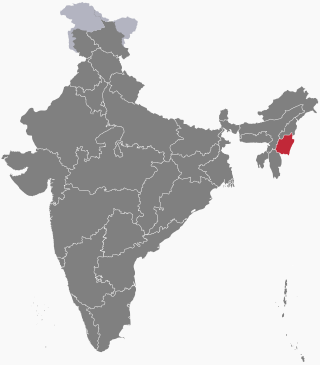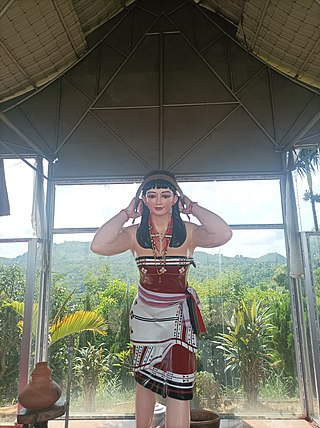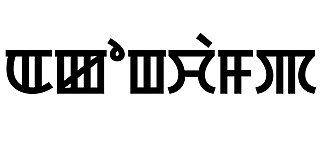Related Research Articles

Meitei, also known as Manipuri, is a Tibeto-Burman language of northeast India. It is spoken by around 1.8 million people, predominantly in the state of Manipur, but also by smaller communities in the rest of the country and in parts of neighbouring Myanmar and Bangladesh. It is native to the Meitei people, and within Manipur it serves as an official language and a lingua franca. It was used as a court language in the historic Manipur Kingdom and is presently included among the 22 scheduled languages of India.

Panthoibi is a goddess associated with civilization, courage, fertility, handicraft, love, victory, warfare and wisdom in the mythology and religion of Ancient Kangleipak. She is a consort of the God Nongpok Ningthou. She is considered to be one of the divine incarnations of Leimarel Sidabi and is also identified as a form of Goddess Nongthang Leima. She is worshipped mainly by the Meitei people in Manipur, Assam, Tripura, Bangladesh and Myanmar.

Meitei deities are the deities affiliated to Meitei mythology and Meitei religion (Sanamahism) of the Meitei people of Manipur. Among many gods, main Meitei gods are Atingkok, Asheeba (Sanamahi) and Apanba (Pakhangba). Among many goddesses, main Meitei goddesses are Leimarel Sidabi, Imoinu (Emoinu), Panthoibi and Phouoibi (Phouleima).

In Meitei mythology and religion, Nongthang Leima is the goddess of seduction, thunder, and lightning. She was created by Atingkok to attract Haraba (Pakhangba). She mastered thunder and lightning in the chaos in the early world. She predicted the first rain. She limits the chaos and helps creation.

Meitei nationalism refers to nationalism among the Meitei people. In the Meitei context this includes various movements throughout history to sustain Meitei cultural identity, political boundary, ethnicity and history to regain sovereign state status of Kangleipak.

Haoreima or Haoleima is a goddess of tragic love and separation in Meitei mythology and religion of Ancient Kangleipak. According to some legends, she was a woman from the hills, who was killed while arranging to meet her lover, and turned into a tortured spirit. She is regarded as an incarnation of Goddess Panthoibi. She is also identified with goddess Nongthang Leima. She is also worshipped as goddess Ireima. She is one of the most revered Meitei goddesses, though she is of Tangkhul origin.

Phouoibi (Fouoibi) or Phouoipi (Fouoipi) or Phouleima (Fouleima) or Phoureima (Foureima) is the goddess and the female personification of the agriculture, crops, fertility, grains, harvest, paddy, rice and wealth in Meitei mythology and religion of Ancient Kangleipak (early Manipur). She is the lover of Akongjamba, a hero in ancient legends. But fate doesn't permit the lovers to unite. So, Phouoibi and Akongjamba reincarnated in the legends. She was sent by Thangching (Thangjing) to Kege Moirang (Keke Moilang) kingdom to prosper the human world. The legends of her love with Akongjamba were believed to be enacted by Thangching (Thangjing) as a part of the Epic cycles of incarnations (Moirang Saiyon) of the Moirang Kangleirol legends.

Akongjamba was a nobleman of a King in Ancient Moirang in Meitei mythology and folklore. He was a lover of the harvest Goddess Phouoibi, but fate didn't permit the lovers to unite, so they reincarnated. The lives of the two legendary lovers were believed to be enacted by Thangjing as a part of the Epic cycles of incarnations.

Koupalu is a primordial deity in Meitei mythology and religion. He is the Guardian of the North West direction. Legend says he is the founder of civilization in Ancient Manipur, starting from the Mount Koubru, a peak where he abodes, in north-western Manipur.

Meitei mythology or Manipuri mythology is a collection of myths, belonging to the religious and cultural traditions of the Meitei people, the predominant ethnic group of Manipur. It is associated with traditional Meitei religion (Sanamahism). Meitei myths are a part of Meitei culture and explain various natural phenomena, how the human civilization developed, and the reasons of many things happening. Most of the Meitei legends are found in the Meitei language texts.

Thangching or Thangjing is a primordial deity in Meitei mythology and religion of Ancient Kangleipak. He is the ruling deity of the Moirang dynasty of Ancient Moirang. He rules supreme on the banks of the landlocked sea, Loktak lake. He is one of the four cardinal Umang Lais. The guardianship of the south western direction is alluded to Thangjing and the other directions to Koubru, Marjing and Wangbren.

Nongda Lairen Pakhangba, was the first Meitei monarch of the Ningthouja dynasty, who ascended the throne of the Kangla of Kangleipak in 33 AD, after the withdrawal of the mainstream powers of the Khabas. Before the reign of king Nongda Lairen Pakhangba, the clans, or salais were already in existence.

The ancient legend of Khuyol Haoba and Yaithing Konu is one of the epic cycles of incarnations of Meitei mythology and folklore, that is originated from Moirang kingdom of Ancient Kangleipak. It concerns the fateful love of Khuyol Haoba, an orphan man, for the beautiful Yaithing Konu. Khuyol Haoba was the son of late Khundouremba, a court official of Moirang. Yaithing Konu was the daughter of Luwang Huiningsumba, an influential nobleman of Moirang.

The ancient legend of Wanglen Pungdingheiba and Sappa Chanu Silheibi is one of the epic cycles of incarnations of Meitei mythology and folklore, that is originated from Moirang kingdom of Ancient Kangleipak. It concerns the tragedic romantic adventures of Wanglen Pungdingheiba for his ladylove Sappa Chanu Silheibi . Wanglen Pungdingheiba was a skilled craftsman known for making musical instrument pung. Lady Sappa Chanu Silheibi was a skilful weaving artisan. Both the lovers are equally noted for their talents and good looks, thereby becoming the matters of envy of many young men and women in the kingdom of Moirang.
Koiren Leima or Leinung Yuchakha Chanu or Ayangleima is the name of the consort of Thangjing, the presiding deity of Ancient Moirang, a province in Ancient Manipur. There are two goddesses, Ayangleima Ahal and Ayangleima Atonpi, who are the first and the second wives of the god respectively. Their accounts are mentioned in the Moirang Ningthourol Lambuba, the royal chronicle of Ancient Moirang.
Luwang Ningthou Punshiba, shortly known as Luwang Punshiba, is a king of the Luwang dynasty of Ancient Manipur civilization. He is best known for his long life and outstanding wisdom in Manipuri folklore and history of Manipur.
Meidingu Hongnemyoi Khunjao Naothingkhong was a Meetei ruler of Ningthouja dynasty of Ancient Manipur. He was the successor of Ura Konthouba and the predecessor of Khongtekcha. He ran away from the Kangla at the age of about 10 or 12 years and went to live along the Shelloi Langmais in the Nongmaiching Hill in the eastern Manipur. He was mad in love with Pitang-nga, a Langmai girl and married her. They lived in her parents' house. This is the first reference to the matrilocal residence in the history of Manipuri ethnicity. According to ancient sources, he has six wives from different clan principalities of Ancient Manipur. In fact, he has nine total wives, out of which three are childless. So, in general cases, it is regarded as he has six wives. He married Princess Ewanglon Namun Chaobee after engagement. Luwang Ningthou Punshiba of Luwang dynasty gave training of state craft and the art of governance to Naothingkhong when he was a prince. Besides, the great-grandson of Luwang Ningthou Punshiba married Naothingkhong's daughter.
Meidingu Naokhamba was a ruler of Ancient Manipur. He is the successor of Kaokhangba and the predecessor of Naophangba. During his reign, Manipuri traders reached out on horseback to upper Burma and China. Besides the Cheitharol Kumbaba and the Ningthourol Lambuba, he is also mentioned in the Chengleiron. Naokhamba abducted the wife of King Thangyi Khongjromba of the Chenglei tribe when she was heavily pregnant. Later, she had a son named "Naophang Ahanba". During his reign, Chingjen Naran Panggalba, the king of the Chengleis left Kangleipak for westward lands.
Meidingu Naophangba was a Meetei ruler of Ningthouja dynasty of Ancient Manipur. He is the successor of Naokhamba and the predecessor of Sameiraang. He promulgated a proto-Constitution in 429 AD, which later grew into the Loyumba Shinyen, a written constitution in 1100 AD, during the reign of King Loyumba. He is one of the most outstanding figures in the history of Meitei architecture of Ancient Manipur. He laid the foundation stone of the Kangla, the "Namthak Sarongpung", which is the holiest place to the Manipuri ethnicity. During his reign, the coronation hall in the Kangla was inaugurated and a hog was sacrificed. According to the Loyumba Shinyen, he took command from Mangang Luwang Khuman for the administration of justice in the kingdom. According to the Chakparol, the ten villages of the Chakpas separated during his reign. It was right from his reign that the newcomers (immigrants) were assigned and admitted to the yek salai (clans) and the yumnaks (families) of the Meitei ethnicity. According to the Thengkourol, copper and brass were imported from Burma and China during his reign.
Khui Ningomba was a ruler of Ancient Manipur. He was the successor of Emperor Taothingmang.
References
- ↑ Ray, Asok Kumar; Chakraborty, Satyabrata (2008). Society, Politics, and Development in North East India: Essays in Memory of Dr. Basudeb Datta Ray. Concept Publishing Company. ISBN 978-81-8069-572-8.
- ↑ Devi, Jamini (2010). Cultural History of Manipur: Sija Laioibi and the Maharas. Mittal Publications. ISBN 978-81-8324-342-1.
- ↑ Anvīkshā. Jadavpur University. 2004.